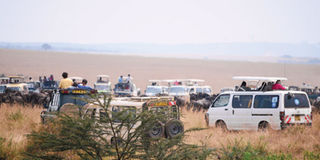Animal-eat-animal season in the Mara

Tourists at a watch wildebeest crossing point on the Mara River at the weekend. Photo/GEORGE SAYAGIE
A spectacular scene has been unfolding in the Maasai Mara in the last month, as the animal kingdom treats Kenya’s tourists to what is arguably a wonder of the world in its own right.
More than 1.4 million wildebeest and a herd of 200,000-plus zebras and gazelles have already migrated into the Maasai Mara from the Serengeti plains in Tanzania.
The migration is expected to continue in the next three months, according to wildlife monitors at the Maasai Mara Game Reserve, its chief warden Michael Ole Koikai said on Wednesday.
But as the migration continues, it has been a field day for the predators, especially the lions and leopards, which are changing their diets from antelopes, buffalos and zebras.
On offer too, are the wildebeest as the animals are easy prey due to their large population and herd mentality.
Time of their lives
Crocodiles too, are having the time of their lives, closely following the wildebeest migration, then lay in wait for an opportunity to strike as the wildebeest make their way into different territories.
This is one of the most exclusive scenes tourists at Maasai Mara are now enjoying.
Wildlife monitor Douglas ole Naisho says the migration has brought balance to the Mara eco-system.
Mr Naisho told the Nation that more than 250,000 of the wildebeest die from drowning, stampede, or are attacked by predators.
“But even this great migration carnage is not enough to reduce the wildebeest numbers. The deaths during migration are replenished by the more than 400,000 births a year,” said Mr Naisho.
Tourist camp director Antony Ole Tira who has been in the industry for the last 15 years said the deaths during migration are now considered a natural population check — “natural selection at its best”.
Mr Tira said a smattering population of other bovids — ruminant hollow-horned animals, including sheep, goats, antelopes cattle, zebras, gazelles and buffalo — join in the migration.
“Lion prides also escort and welcome the migrating wildebeest on either side of the Mara River Crossings. The lions fill up their stomachs with gnu carcasses so much the prey in turn subdues the prides in the plains with little fear.
“As long as a lion has had his 35 or so kilogrammes of meat a day, it poses no threat,” said Mr Tira. “All that wildebeest need is to sacrifice a cousin here, a distant aunt there and they are fine. It’s surely a game of numbers,” he added.
Leopards on the other hand, don’t have to move far to hunt. All they’ll do is pounce on unsuspecting wildebeest as they pass by the leopards’ tree parches.
The rest scatter as usual in different directions.
“It’s just another sacrifice after all; they still got numbers, no matter what,” Mr Tira concludes.



